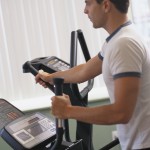 Creating a Habit for Beginner Exercisers
Creating a Habit for Beginner Exercisers
New to exercise? Fantastic! First of all, congratulations on making the decision to become healthier!
I’ve met many Brand-New-to-Exercise members during my years at the gym, and the most common mistake they make is overdoing it at the beginning. To avoid that pitfall, which can lead to injury, disappointment or even quitting, beginner exercisers can start with some simple cardio. Cardiovascular exercise strengthens your heart, builds endurance and burns calories. It’s a great way to create the habit of increasing the amount of activity in your life.
First, choose an exercise that you enjoy doing. The good news is that there are so many different types of cardio to choose from! Walking indoors or outside, cycling, hiking and swimming are all great low-impact activities that will raise your heart rate.
Next, make a plan to do your chosen activity 2-3 days a week. Look at your schedule or calendar, and write it down or create a reminder. If it’s in your planner, just like any other important appointment, you are more likely to stick to it.
When doing the activity for the first time, make sure you warm up at a slower pace for 5-10 minutes before increasing the pace. Plan on moving for 20 minutes at a time, including the warm-up. Remember, we don’t want to overdo it the first time!
After you’ve succeeded in fitting in 3 cardio workouts in one week, it’s time to increase the duration. Add 5 minutes to each workout the following week, for a total of 25 minutes. Once you’ve achieved 3 workouts in a week at 25 minutes, add another 5 for a total of 30 minutes.
Don’t worry about distance or speed just yet; as a beginner, your main focus is fitting exercise in regularly and making the habit stick. Once you’ve been regularly exercising, mix it up by trying a new activity or increasing the intensity. And at this point, you’re no longer a beginner! You’ve made being active a normal part of your life!
Follow Sarah on Twitter @SarahJChicago
 Subscribe
Subscribe




